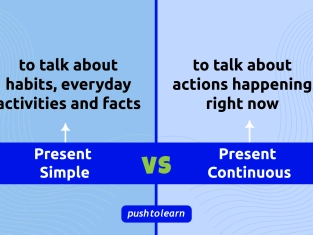by PushtoLearn
Present Continuous
Table of Contents
Present Continuous - Exercises and Quiz
These exercises focus on using Present Continuous to talk about ongoing actions.
What is the Present Continuous Tense?
The Present Continuous tense is used to describe:
-
Actions happening right now
-
Example: I am reading a book. (I am reading at this moment.)
-
Temporary actions
-
Example: She is staying with her friend this week. (She doesn’t usually stay there.)
-
Future plans
-
Example: We are visiting our grandma tomorrow. (A plan for the future.)
-
Changes and trends
-
Example: The weather is getting colder. (The weather is changing.)

How to Form the Present Continuous
To form the Present Continuous, we use:
[Subject] + [am/is/are] + [verb + ing]
|
Subject |
Helping Verb (am/is/are) |
Verb + ing |
|
I |
am |
playing |
|
You |
are |
eating |
|
He/She/It |
is |
watching |
|
We |
are |
working |
|
They |
are |
running |
Examples:
-
I am watching TV.
-
She is cooking dinner.
-
We are studying for the test.
Spelling Rules for -ing Verbs
When adding -ing to verbs, follow these rules:
|
Rule |
Example |
|
Most verbs – Just add -ing |
play → playing |
|
Verbs ending in -e – Drop e and add -ing |
make → making |
|
Verbs with one vowel + one consonant – Double the consonant and add -ing |
run → running |
|
Verbs ending in -ie – Change ie to y and add -ing |
lie → lying |
Common Mistakes
1. Forgetting the helping verb
❌ She cooking dinner.
✅ She is cooking dinner.
2. Using the wrong form of “to be”
❌ They is playing soccer.
✅ They are playing soccer.
3. Using the simple present instead of present continuous
❌ I eat now.
✅ I am eating now.
When NOT to Use Present Continuous
We do not use Present Continuous with non-action verbs (also called stative verbs). These verbs describe feelings, thoughts, possession, or senses.
|
Wrong (❌) |
Correct (✅) |
|
I am knowing the answer. |
I know the answer. |
|
She is having a car. |
She has a car. |
|
He is liking ice cream. |
He likes ice cream. |
Some common stative verbs include:
like, love, hate, know, understand, believe, want, need, have (possession), see, hear, smell, taste.
Present Continuous in Everyday Life
You hear the Present Continuous tense all the time! Here are some real-life situations:
-
At work:Sorry, I am working right now. Can I call you later?
-
With friends:We are meeting at the café at 5 PM.
-
At home:Mom is cooking dinner in the kitchen.
-
On the phone:Hey! What are you doing?
FAQs about Present Continuous
When should I use Present Continuous instead of Present Simple?
Use Present Continuous for actions happening now (I am reading) and Present Simple for habits (I read every night).
Can I use Present Continuous for the future?
Yes! You can use it for planned future events. (We are traveling to Paris next week.)
What is the difference between “I am thinking” and “I think”?
-
I am thinking about my future. (Temporary action)
-
I think she is nice. (Opinion, not an action)
Why can’t I say “I am knowing”?
Because “know” is a stative verb. It describes a state, not an action. Use “I know” instead.
Can I use Present Continuous in negative sentences?
Yes! Just add not after the helping verb:
-
She is not sleeping right now.
-
We are not going to the party.

